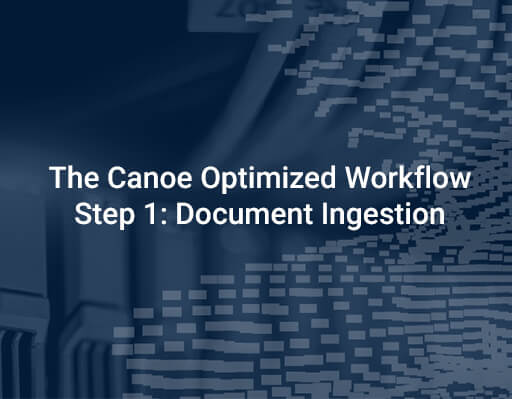The Canoe Optimized Workflow Step 1: Document Ingestion

This article is part one of a five-part series covering each aspect of the Canoe Optimized Workflow. The Canoe Optimized Workflow is a roadmap for any organization investing in or allocating to alternative investments to unlock new efficiencies and reimagine their operational processes by leveraging a combination of breakthrough technology and industry expertise.
Never Miss an Investment Document Again
The first step of any reporting process for firms like OCIOs, Investment Consultants, Institutional Asset Servicing Firms, Fund of Funds, Institutional Asset Owners, Family Offices, and Wealth Managers is always the same. Every organization needs to gather, access, aggregate, and make sense of the reporting documents from multiple sources, disparate formats, and varying frequencies. At face value, this sounds simple, but it can actually be one of the most time-consuming tasks for these firms managing complex portfolios. Depending on volume and firm size, some organizations spend thousands of hours a year simply retrieving documents and triaging email inboxes.
More specifically, recurring investment documents like Capital Account Statements, Call Notices, Distribution Notices, K-1s, Fact Sheets, Quarterly Financials, and Manager Letters are sourced from multiple locations, including various portals, like Intralinks and internal email inboxes or folders. As these documents and reports are prepared by different parties, there is no standardization in document structure nor a reliable way to extract data from these PDF reports.
Moreover, understanding which documents you have and which you’re missing can be a frustrating exercise, particularly during month-end or quarter-end reporting cycles. One missing document can delay the entire workflow. And, across thousands of expected documents to be received, it can be quite easy for certain correspondence to slip through the cracks. Unwinding the resulting inaccurate or latent reports is another time-consuming process.
Some of the challenges thus include:
- Scalability. Large teams of people either off-shore or in-house are needed to manually review massive financial packages from thousands of investment managers on a quarterly basis. Each document requires a detailed, page-by-page review in order to locate the pertinent data points and elements. Then, this data must be manually typed into an internal database for client reporting. Not a scalable solution.
- Timeliness and Client Service. Client reports can only be created as fast as the teams have access to the relevant reporting data. As the process of ingesting this data is so cumbersome, additional review steps are needed to ensure that no fat-finger errors occurred and that the numbers stated are accurate. In fact, in many cases, the front office and back office are unknowingly spending their time on the same data entry and review tasks. All of these manual steps require more time and human resources which often delay client service and actual client receipt of their vital investment reports. Further, some firms may tier their clients based on service levels such that they need to prioritize certain reports. Understanding which high-priority documents have been received so clients can take action is a challenge managed by manual triaging. Automated alerts to proactively identify important documents in real-time is a significant value-add for operational teams.
- Managing Missing Documents. When dealing with thousands of reports on a quarterly basis, it is easy to miss or overlook a document or two. A document may be late or perhaps the investment manager sent it to the wrong location. Either way, not having access to these particular documents can become increasingly frustrating when under deadline to compile client performance reports. Being alerted to these missing documents and how late they are can become incredibly helpful in streamlining your process.
Our team understands these challenges, intimately. Many members of the Canoe team were affected by this burdensome and error-prone process when working at global investment firms and fintech analytics providers. Each, separately, recognized the need for smarter technology to automate the ingestion process.
In 2014, our cofounders led the charge in building a scalable solution for Portage Partners, a New York-based firm focused on sourcing, evaluating, and monitoring a broad array of alternative funds and direct investment opportunities. This solution has evolved into Canoe Intelligence.
Canoe solves the document ingestion problem for alternatives.
- One inbox. Canoe ingests all of your documents from multiple email inboxes, document portals, and bulk uploads. Individuals and teams no longer need to manage portal login credentials and passwords. All of this information is securely sent and stored in Canoe. Upon receipt, Canoe automatically categorizes and renames each document. This eliminates manual data entry and any human error from the process.
- Predictive tagging and real-time alerting. As Canoe works with more and more clients, our shared intelligence is able to identify and flag missing and late documents. This allows you to run your reporting with real-time transparency, and ensure that reports do not slip through the cracks and that you’re compliant with client expectations. This empowers you to transform your current manual review process.